Using Soil Moisture Sensors for Vineyard Irrigation Management
A Practical Guide for Installing and Interpreting Information from Soil Moisture Monitoring Technologies in Vineyards
Fritz Westover and Kris Beal
Introduction
Grape growers are encouraged to use a combination of soil, plant, and weather data when determining the length and frequency of irrigation events in vineyards. The most common questions growers want to answer with regard to vineyard irrigation are:
- How often should the vineyard be watered?
- How much water should be applied per irrigation?
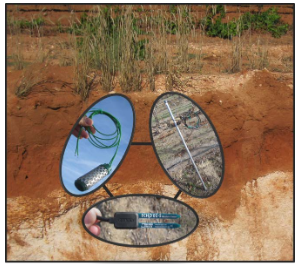
Estimation of daily evapotranspiration can tell a grower roughly how much water is removed from the soil, and is the principle means by which growers can determine the amount of water to apply to a vineyard block. Plant data (such as leaf or stem water potential determined by means of a pressure chamber) is often used to determine how vines are responding to the amount and frequency of water applied. For example, if a grower wishes to strategically apply less water than the amount lost to evapotranspiration (a deficit irrigation strategy) a plant water status measurement can be used to indicate the degree of water stress the vines are experiencing.
Why measure soil moisture?
Soil moisture sensors are a useful tool for assisting with vineyard irrigation scheduling. For example, water status of the soil can be measured during the dormant season to determine if winter rainfall is reaching the effective rooting area of vines. Soil moisture sensors are also helpful for determining the length of irrigation time required to replenish water to a desired rooting depth. The data provided by soil sensors can help growers to understand how water moves in soil and the areas where roots are most actively taking up water, potentially reducing excess water application. In areas where water quality is affected by high salts, soil moisture sensors can provide valuable feedback regarding the effectiveness of irrigation or rainfall with regard to potential leaching of salts outside of the root zone. Proper placement of soil sensors is critical for obtaining data that will be useful to improve vineyard irrigation scheduling.
Part 1: Selecting Locations to Install Soil Moisture Sensors in Vineyards
Selecting a representative location
Ideally, a grower would install soil moisture sensors in multiple locations per irrigation block to obtain an average of soil moisture across a site. However, the cost of sensors and the associated telemetry devices required to retrieve data from a large number of data logging stations is often a limiting factor when choosing the number of sensors to install. For this reason, it is most common for growers to install moisture sensors in only one or two sites within an irrigation block. When implementing a small number of data points across a vineyard, it is important to choose a soil profile that best represents the majority of the irrigation block.
For example, installing soil moisture sensors in an area of shallow soil or with less water holding capacity than is typical of the whole block can potentially result in sensor readings that overestimate the frequency of irrigation sets needed within that block. Conversely, the installation of sensors in an area having deeper, heavier clay soil than is typical of the block will result in sensor readings that potentially underestimate the water needs of the whole block (Figure 1).
Mapping vineyard soils
Ideally, a vineyard soil will be fully mapped prior to designing a vineyard and establishing irrigation blocks to be irrigated differently as needed. Soil maps are available online from the United States Department of Agriculture, National Resource Conservation Service (USDA-NRCS) - Web Soil Survey (Figure 1). (http://websoilsurvey.sc.egov.usda.gov/)
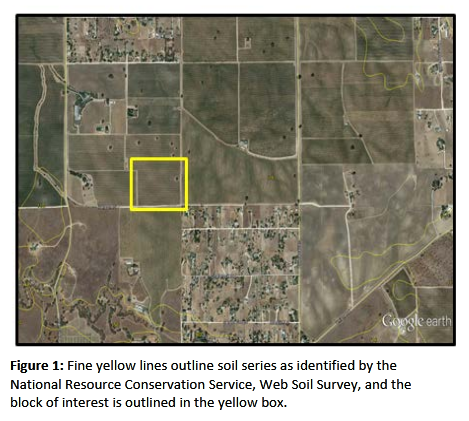
These maps show the approximate boundaries of distinct soil series and can serve as a good starting point for determining where a soil may change within a site.
Maps from the USDA-NRCS are helpful to describe the soil type of an area, however they not accurate enough to be used alone for selecting where to install soil moisture sensors. On-site mapping of vineyard soils by a soil scientist or vineyard soil expert is recommended to understand the precise boundaries of different soil types. Soil characteristics that may change across a soil series include effective rooting depth, depth to bedrock or hardpan, soil texture, and depth of distinct soil horizons.
The process of mapping a soil involves excavation of multiple soil observation pits across a site in order to establish where changes in soil characteristics occur. The potential influence of different soils on plant growth is then estimated based on the knowledge and prior experience of the soils expert. Before a vineyard is planted, soil pits can be excavated using a backhoe. Additionally, hand operated soil augers can be used to capture disturbed soil profile samples and assist in delineating changes in soil across a block. Hand or electric powered augers will disrupt less soil volume on a site. In established vineyards, large excavation equipment can be more difficult to maneuver, making use of portable hand or mechanical augers more accessible.
Key Concepts
Soil sensors must be installed in the location that best represents a vineyard irrigation block.
Mapping soil (pre and post planting) and vine vigor patterns (post planting) provides useful information for selecting sensor installation sites.
A strategy must be developed to evaluate the soil in a block to verify placement of sensors in a representative soil profile.
Mapping vineyard vigor
Differences in soil across a vineyard block often contribute to growth differences in vines as observed in the canopy. Vegetation index maps, often referred to as “vigor maps,” are helpful tools for understanding differences in relative vigor across a mature vineyard block. Differences in vigor may be due to numerous factors, including changes in soil characteristics.
Normalized Difference Vegetation Index (NDVI) mapping is one of the most commonly used tools for tracking differences in vegetative growth across a vineyard (Figure 2). NDVI images provide a snapshot in time (e.g., mid-summer) when the relative canopy size and health can be compared within a vineyard block. Vines or areas of low NDVI will use less water, drying the soil at a slower rate than vines or areas with a higher NDVI. Additional, low tech measures can be taken to verify growth differences observed from NDVI maps, including dormant pruning weights of vines and visual observation.
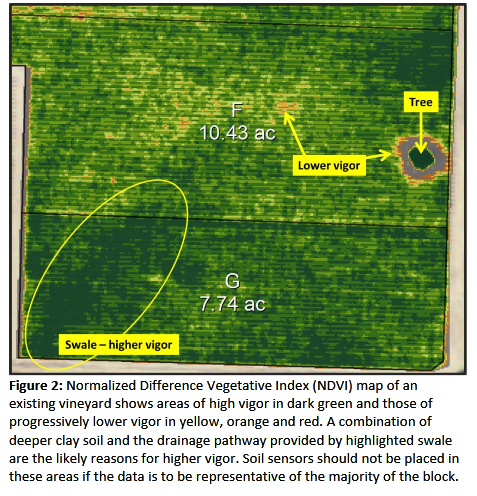
Pre-plant considerations
Uniform vine growth is desired within a vineyard block. Variability of soil across a vineyard site should be considered when designing the layout of vineyard blocks and irrigation. In general, larger vineyard blocks are more economical to establish and manage, therefore it is not always practical to divide blocks by soil type. However, irrigation design in the pre-plant phase allows a grower to customize a system across a block, such as developing separate irrigation zones to address differences in soil water holding capacity. It is also useful to have historical photos or satellite images and crop use information to identify areas of the site that may have had large areas of soil disturbed (e.g. uprooted trees, trenching for pipelines, compacted roadways).
Choosing sensor locations in an existing vineyard
The goal when choosing sensor locations in an existing vineyard block is to locate an area of the vineyard with soil that best represents the majority of the irrigation block. Placement of sensors in the outlying soils of lowest or highest water holding capacity can result in soil moisture readings that lead to either excess or under-irrigation. Supplemental irrigation may be needed in the weakest area of the vineyard block.
In Figure 3 we see a photo of four disturbed soil cores taken with a four-inch hand auger in the 8 acre Cabernet Sauvignon block of interest. The soil core from the higher elevation (D) comes from the east side of the block. The two soil cores in the middle (B,C) are from the center of the block just east of the swale. The soil core from the lowest elevation (A) is from the center of the high vigor swale area on the west side of the block. Note that the soil from the high vigor area (A) of the vineyard has clay content as deep as four feet, whereas the soil core from the top of the hill (D) has heavy clay top soil down to about two feet, followed by a sharp transition to loam. The two cores from the center of the block (B,C) are of the most representative soil, having a sandy clay loam top soil, transitioning to clay loam, then loam subsoil.
After reviewing soil maps and vine vigor, a strategy can be developed to evaluate soil in the irrigation block. The map in Figure 4 illustrates a grid of points where disturbed cores were taken to evaluate soil horizon depth. The location for soil sensor placement was selected in an area that represents the most commonly observed soil profile across all sample sites (Figure 5).
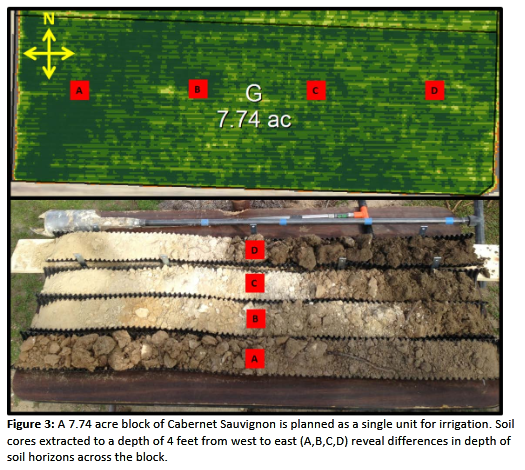
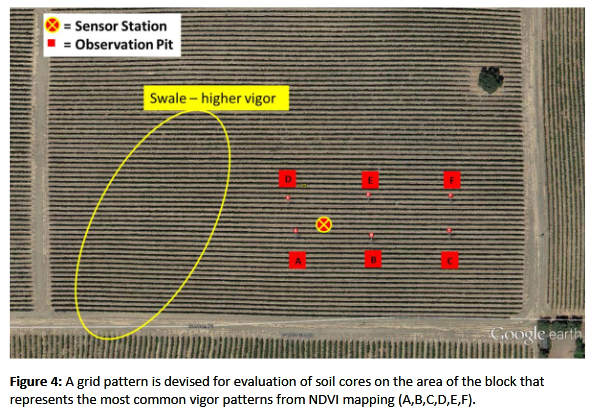
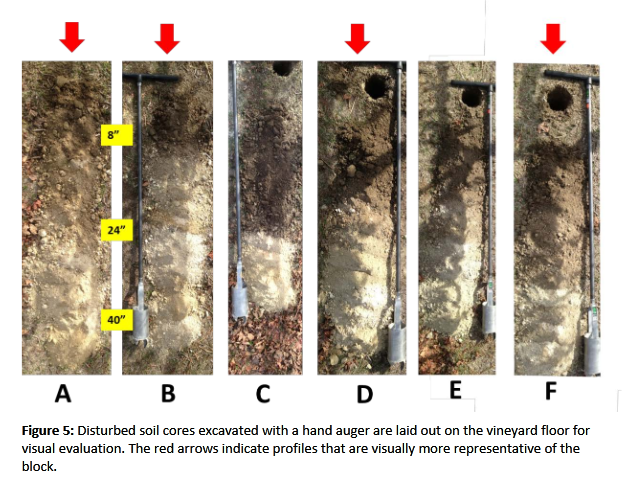
Part 2: Depth of Soil Sensor Placement and Proximity to Drip Emitters and Vines
Depth of sensor placement
After determining the most representative location for placing soil moisture sensors in an irrigation block, the depth of sensor placement must be considered. Choosing the depth to place individual soil moisture sensors requires careful evaluation of the soil profile. Due to the deep rooting habit of grapevines, it is common to place sensors at increasing soil depths in order to capture the movement and potential availability of water (Figure 6).
When using a probe type sensor with multiple sensor depths pre-set by the manufacturer, the most important decision is the total length of probe required to reach the desired soil depth. Be sure that the length matches the depth with which you wish to monitor water movement and that the soil depth is adequate for full insertion of the probe. A sensor at or near the bottom of the root zone is suggested to identify deep percolation.
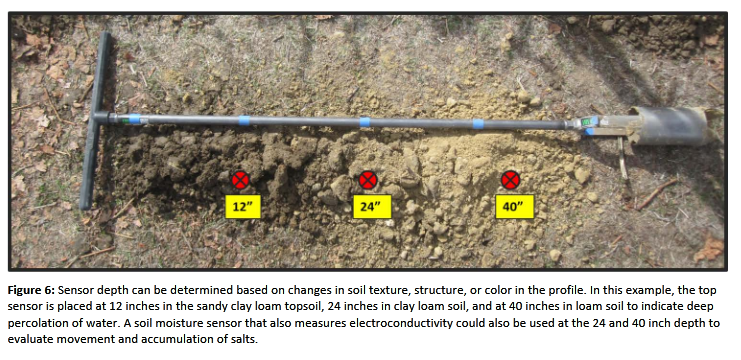
In Figure 6 the sensor depths chosen were based on changes in soil texture: 1) 12 inches in sandy clay loam 2) 24 inches in clay loam and 3) 40 inches in loam to indicate deep percolation. In general, the most shallow soil sensors should not be placed less than 8 inches from the soil surface due to the high fluctuation of water content.
Before final installation of soil sensors, observation points can be evaluated in the area immediately surrounding the sensor location (Figure 7). Evaluation of a soil profile within 2-3 feet of a proposed installation site is a helpful practice to make sure you do not install sensors in a disturbed spot. Note, any observation hole dug within a few feet of a sensor site must be carefully backfilled and tamped to prevent rainfall or other surface water from influencing sensor readings.
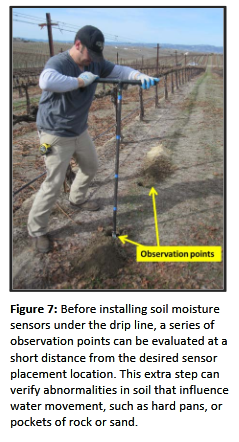
Sensor placement relative to emitters and vines
The location of soil moisture sensors relative to the vine root system and drip emitters (in irrigated vineyards) will influence the usefulness of the sensor readings. If sensors are placed too far from active roots the effect of water movement in mass flow cannot be captured. Likewise, placement too far from the emitter can lead to excess watering of vines if the sensor is not within the desired wetting pattern of a routine irrigation set. Most growers will tend to err on placing sensors closer to the emitter (within 4-6 inches) in order to avoid over watering. Some trial and error may be necessary to find the best distance from emitters in a particular soil. Soil sensors are most commonly positioned within 18 inches of a vine trunk and in line with trellis and irrigation wires to reduce damage from machinery (Figures 8,9).
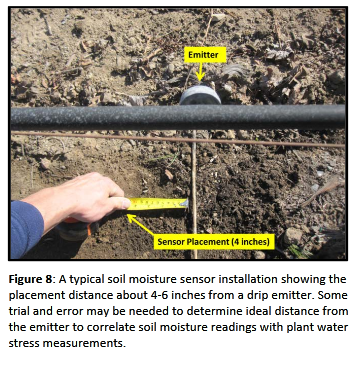
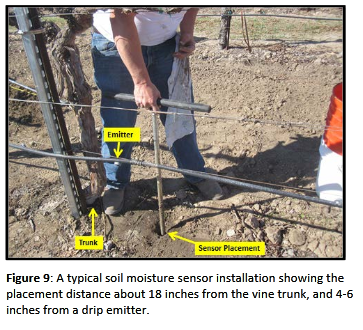
Where to avoid placing sensors
In general, sensors should not be placed in the following areas of the vineyard:
- Areas of excessively high or excessively low vigor that do not represent the majority of the block
- Areas that do not drain well or hold water longer than the majority of the block
- Areas where soil depth is deeper or shallower than the majority of the block
- Pockets of soil that do not represent the majority of the block (e.g., random sand pockets, or hardpan)
- Areas in line with surface runoff (i.e. bottom of swales) or drainage channels in a block
- Areas on the border of the vineyard or areas near competing vegetation
- Areas that receive supplemental shade from structures other than vines or trellis
- Areas where natural soil structure has been disturbed in the past (e.g., backhoe pits, uprooted trees, backfill from erosion) (Figure 10)
- Areas that may receive significantly more or less irrigation water than the rest of the block (this may be based on evaluation of distribution uniformity)
- Areas where vines are not representative of the block (e.g., weak vines, vines of different age or rootstock)
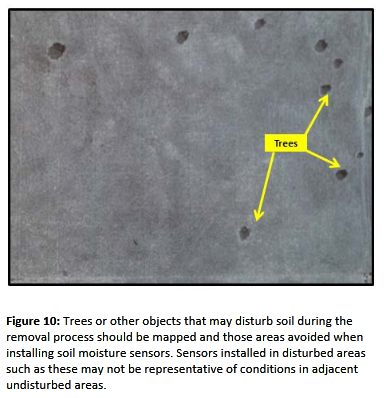
Key Concepts
Depth of sensor placement should be determined based on distinct changes in soil texture and effective vine rooting depth.
Sensors placed at increasing depths can provide indication of water movement and deep percolation.
An ideal distance from the drip emitter and vine must be determined to capture changes in soil moisture representative of water uptake by vines.
Part 3: Common Types of Soil Moisture Sensors and Tips for Installation
Examples of Common Soil Moisture Sensors
There are many types of soil moisture sensors marketed for use in vineyards. The purpose here is not to determine which sensor type is best, but to provide an overview of common sensor types and how they work. Three common methods used to measure soil moisture in vineyards include matric potential, time domain reflectometry, time domain transmissometry, and capacitance measurements. Regardless of the soil moisture sensor used, the depth of placement and the proximity to vines and drip emitters must be determined prior to installation. How you install the sensors is likely more important than the type of sensor chosen. An online tutorial is available below to provide tips on installation with respect to soil depths and proximity to drip emitters.
VIEW A TUTORIAL ON SELECTING SENSOR INSTALLATION DEPTHS & PROXIMITY TO EMITTERS.
Matric Potential Sensors
Matric potential is a measure of how tightly water is held to the soil, which corresponds to water available to roots. Matric potential is also referred to as soil water potential, water tension, or soil water suction. Some devices, such as tensiometers, read soil water suction directly. Others, such as electrical resistance devices, indicate suction indirectly. These qualitative measures of soil moisture are useful to indicate when to apply water, but are limited in their ability to indicate how much water to apply. Using these sensors, it is possible over a season or two to determine soil tension (centibar) levels at field capacity, wilting point, and maximum depletion point. Matric potential sensors are commonly installed into the soil at multiple depths.
VIEW A TUTORIAL ON TIPS FOR INSTALLING MATRIC POTENTIAL SENSORS.
Capacitance Sensors
Capacitance sensors measure volumetric or relative water content using dielectric permittivity of soil. Excitation is placed in soil by the sensor and the frequency of that wave is affected by dielectric permittivity, which is affected by the water content. The greater the soil water content, the smaller the frequency. Volumetric water content can be used to help decide when to irrigate and how much water to apply. This type of sensor measures a relatively small volume of soil, so installation is particularly important. Capacitance sensors can be purchased as individual sensors or built into a probe or profiler to measure soil moisture at multiple depths.
VIEW A TUTORIAL ON TIPS FOR INSTALLING INDIVIDUAL CAPACITANCE SENSORS.
VIEW A TUTORIAL ON TIPS FOR INSTALLING CAPACITANCE PROBE SENSORS.
Time Domain Reflectometry (TDR) and Transmissometry (TDT) Sensors
Similar to capacitance sensors, Time Domain Reflectometry (TDR) and Transmissometry (TDT) sensors measure volumetric water content (if calibrated) or relative water content (if not calibrated) using high-frequency electromagnetic waves. The waves are passed along two or three parallel probes, and the time required for the wave to pass through the soil or to be reflected back generates the di-electric constant, which relates to volumetric water content. Individual TDR/TDT sensors are larger than other types but measure water content of a larger volume of soil. Volumetric water content can be used to help decide when to irrigate and how much water to apply. These sensors are commonly installed into the soil profile at multiple depths.
VIEW A TUTORIAL ON TIPS FOR INSTALLING INDIVIDUAL TDT SENSORS.
VIEW A TUTORIAL ON TIPS FOR INSTALLING CAPACITANCE PROBE SENSORS.
Pros and Cons of Soil Moisture Sensor Types and How to Choose
For all types of sensors, the installation process is absolutely critical in the ability to obtain accurate and usable soil moisture data. Poorly installed sensors may give erroneous data, leading to mistakes with irrigation amounts and frequency. Using a moisture sensor attached to a data logger (or telemetry to computer/tablet) is the most useful in limited water situations. Continuous measurements can identify soil moisture behavior that might not be evident with point measurements. Instead of watering to a set schedule, you water to need.
VIEW A TUTORIAL ON TIPS FOR INSTALLING INDIVIDUAL TDT SENSORS.
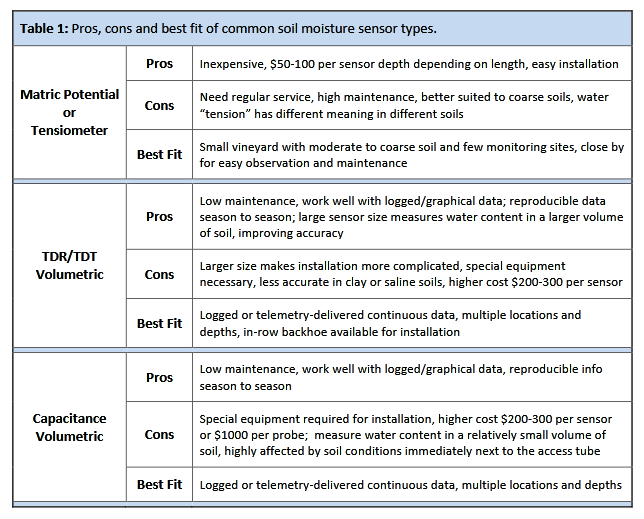
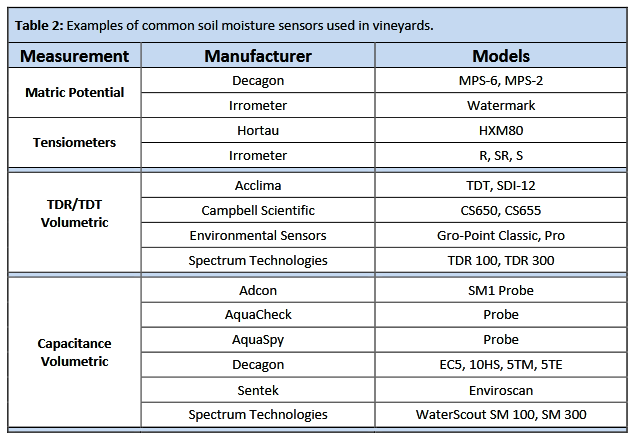
Resources
1. United States Department of Agriculture, National Resource Conservation Service - Web Soil Survey (HTTP://WEBSOILSURVEY.SC.EGOV.USDA.GOV/APP/HOMEPAGE.HTM)
2. Peters, T. R., Desta, K., and Nelson, L. 2013. Practical Use of Soil Moisture Sensors and Their Data for Irrigation Scheduling. Washington State University Extension Fact Sheet - FS083E


